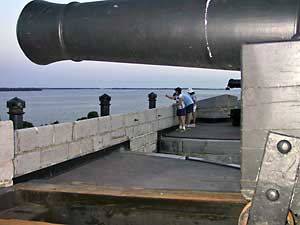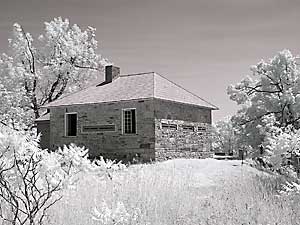Rideau Canal:
Endurance Of Its Military Rationale, 1812-1871
by
Robert B. Sneyd
Robert B. Sneyd completed a Master of Arts thesis at the University of Toronto on the topic of the Rideau Canal. The thesis was titled “The Role of the Rideau Waterway, 1826-1856.” The extensive research that went into this thesis makes Bob the definitive expert on this fascinating period of Rideau history. So while some so called “experts” have erroneously called the Rideau Canal a failure, Bob, through high quality research, has clearly demonstrated that the canal was in fact a success. The canal went far beyond its original mandate to provide a safe military supply route to the naval base at Kingston - it played a pivotal role in the early development of our nation by being a very successful Canadian commercial water route and by being the main route used to safely deliver tens of thousands of loyal British immigrants into Upper Canada.
Bob was the President and CEO of the Centre for Sustainable Watersheds in Portland, Ontario and has been extremely active with various Rideau environmental initiatives (many instigated and organized by Bob).
In this article, Bob takes a fascinating look at the strategic role the Rideau Canal played in the defence of Canada in the 19th century. The article taken from the Fall 2008 issue of "Rideau Reflections" - the newsletter of Friends of the Rideau.
- Ken Watson
In the midst of all its commercial bustle of the 1830s and 1840s, from every strategic military point of view, the Rideau route also steadfastly fulfilled the original purpose for its construction (in contrast to a June 30, 2007, article in the Kingston Whig, which claimed it never served its intended role!). It had been evident as early as 1815 that the American War Department had corrected its faulty wartime strategy and was set to focus on the vulnerable upper St. Lawrence in any future conflict. These lessons of the War of 1812 were as relevant in 1832 or 1846 as they had been in 1815.
 |
| Cannon at Fort Henry
The cannons at Fort Henry face south, towards the U.S. Today they serve more as a magnet for Americans than a deterrent. Fort Henry and the Rideau Canal were part of the infrastructure that kept the vitally important British naval base in Kingston secure. Photo by: Pat Watson
|
The most graphic reminder of this fact was the construction of the fortifications at Kingston; Fort Henry in the 1830s and the Martello Towers in the mid 1840s. In retrospect such paramount military considerations are easy to forget, simply because the expected next war with the United States never came. The Rideau continued to be the vital, secure supply line for Kingston, Lake Ontario and inland Canada for at least two generations after its construction.
Could it have been that this grand military canal acted as a deterrent to American invasion? Did it play a role in helping to keep the peace during these decades of most vital Canadian social, economic and political development? It was, after all, these formative years that made Confederation possible. At any time it is difficult to calculate its effect as a deterrent. Given the magnitude of the expenditure on the Rideau, to say nothing of the imposing nature of the works themselves - and spread out as they were over 200 kilometers of eastern Ontario - no doubt should have remained in the American mind as to Great Britain’s firm resolve to defend the interior of British North America.
The British Undersecretary of State for the Colonies in 1832 was unequivocal: the Rideau was “one of the greatest securities by which we hold the Canadas and the protection of every other great work which either has been, or may be, undertaken there”. On the other side of the Atlantic, the Canadian Commander of the forces urged preparation to “resist … the wonderfully increasing Power of our restless and ambitious neighours”.
Any study of contemporary records in the period of the rebellions (1837-8) reflects the tensions of the day. There was a wave of concern for the need to defend each lock station, lest the pro-American sympathizers attempt to damage the works. Led by a warning from Newboro entrepreneur Benjamin Tett, enough loyal inhabitants on the Kingston side of the watershed were mustered by nightfall on July 4, 1838 to, as he wrote, “prevent the wicked and rebellious Designs of the marauders”.
Still sensitive to the probability of an American war, in 1841 Mulcaster, the Inspector General of Fortifications, underlined the need for permanently established defenses along the route, pointing out that the security of the Rideau was “a primary object in every scheme for the Military Defence of Canada”. Lieutenant-Governor Sir George Arthur contemplated an inevitable American attack: “they hate our government…they hate ourselves; they feel their inferiority to England in civilization, it hurts their vanity, and they will turn upon us when we are in distress”. It was therefore essential to maintain “superiority on the Inland Waters.”
 |
| Stone Defensible Lockmaster's House
Worries about internal rebellion and American invasion continued after the Rideau Canal was built. Defensible lockmaster’s houses, featuring heavy masonry construction and gun slits, such as the one above (Sweeney House at Jones Falls), were built in the 1840s because of these worries. Photo by: Ken Watson
|
The Commander-in-Chief of the British forces, Lord Hill, noted that the Rideau was “the most useful and important work that had been undertaken for the prosperity and security of Canada”. His successor, none other than the venerable Duke of Wellington himself - that master architect and patron of Colonel By’s masterpiece - declared in 1841 that, despite its cost, none could doubt “the wisdom of the plan, its efficiency and above all its Economy”. Notwithstanding Wellington’s understandable bias, what a posthumous testimony to John By, who had been so unceremoniously recalled by political opponents immediately after his completion of the canal a decade earlier!
At the time of the Oregon crisis in 1845-6, war with the United States again seemed “imminent”. But no matter where the crisis in Anglo-American relations, the de facto strategic concern remained. So it was that the original military arguments for the Rideau Canal persisted. And in consideration of the enlargement of the locks at Grenville on the Ottawa River in 1846, the booming voice of Wellington could still be heard. In a letter from that old Tory military hero, bureaucrat and once prime minister, to the young Whig and future prime minister, William Ewart Gladstone, his voice thundered: “No defence of Canada can be undertaken unless this water communication should be completed!”
At mid century - when for the sake of economy the question of transferring the military canals to the provinces arose - military arguments prevailed over the interests of the British Treasury. A joint British commission concluded that, as a military work, responsibility lay with the mother country. The powerful military forces centred in London that had first created the canal still stretched across the Atlantic and held it to Britain.
While, by 1850, self-defence in the Canadas certainly lagged behind self-government, support for the old imperial military ties on both sides of the ocean was nonetheless waning. With the collapse of revenues after 1847, maintenance costs for the canal were becoming an increasing burden on the British taxpayer. In a few short years, as the British military was centralized and brought directly under the control of parliament, the Treasury would have its way. The ancient authority of the British Ordnance Board - always the prime link in both building and maintaining the Rideau - was irrevocably undermined. The Rideau Canal was to be transferred to the province. (Perhaps an early example of downloading!) In 1856 - ironically the very year By’s town became the capital of Canada - his canal passed from the control of Great Britain.
Remarkably, however, its fundamental military raison d’etre remained, to span the years of Confederation. The confidential Gordon Commission report of 1862 during the American Civil War declared - in words that might as well have been written in 1815, or 1826, or 1846 - that the old route of the Ottawa and Rideau was “absolutely essential” to Canadian defence. It was the only way to ensure a secure line of communication westward to the Great Lakes. An authoritative British military report two years later reiterated the time-proven mantra: if the Canadian government strengthened the fortifications in Kingston, the Rideau route could supply this vital fortress, which was the key strategic point for the naval and military security of inland Canada.
Thus did the Rideau continue to provide the lynchpin of a defensible border throughout the middle half of the 19th century. The Duke of Wellington - and Lieutenant Colonel John By - could rest in peace! The need for that defended border rapidly declined in the early years of Confederation after the Treaty of Washington. But surely these men, the architect and the builder of the Rideau Canal - Britain’s most expensive overseas military work of the century - would have taken pride on November 11, 1871, to see that during the final withdrawal of British troops from North America, units of the Royal Engineers were among the last to leave Quebec City.
© 2008 Robert B. Sneyd
|